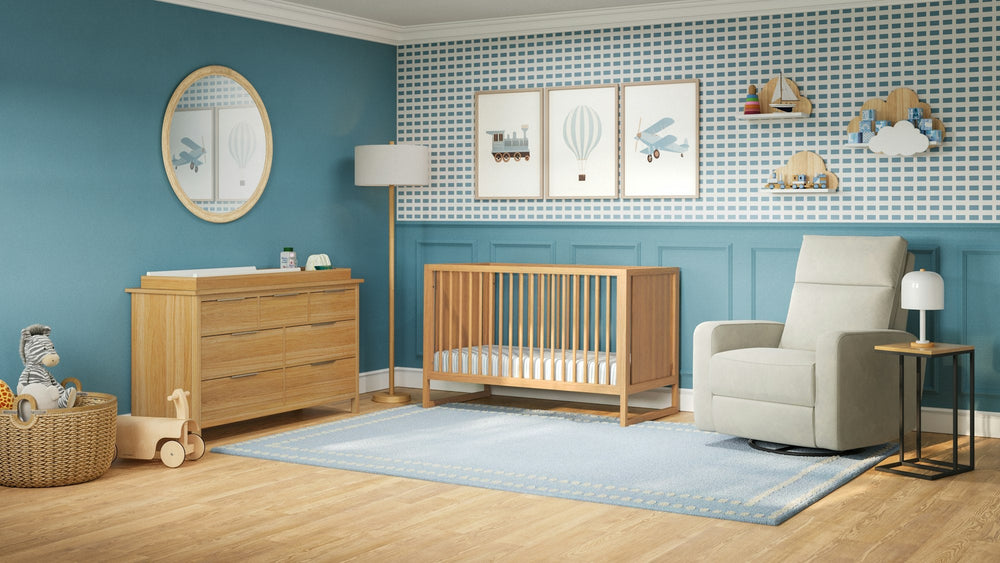Your Second Trimester of Pregnancy: Feeling the Baby Move for the First Time and Much More!

Congratulations on your pregnancy and entering the second trimester! You made it through the first trimester, a time full of questions, critical fetal development, and hormonal changes that may have sent your body for a whirlwind.
The second trimester is often referred to as the “honeymoon phase”, as many troublesome symptoms such as morning sickness, fatigue, and nausea usually subside during this time.
Many pregnant women enjoy this phase of their pregnancy, and I hope you do too. Read on to discover everything you need to know about the second trimester of your pregnancy.
Changes to Your Body and Symptoms
Your body has already gone through numerous changes to accommodate your growing baby, and during the second trimester, it will experience many more. Some of the pregnancy symptoms common during this stage include stomach symptoms, increased blood pressure, hormonal fluctuations, the possibility of gestational diabetes, and cramping in your legs and back.
Let’s take a deep dive into what to expect as these symptoms pop up, when you should escalate symptoms to your healthcare provider, and ways to alleviate some of these annoying side effects of a growing baby.
Stomach Symptoms
Stomach ailments are a common part of pregnancy and an unfortunately normal part of a healthy pregnancy. Some superstitions exist, like if you have heartburn, your baby will be born with a full head of hair, but there is no scientific way to predict anything about your baby’s appearance or gender based on digestive symptoms.
For some women, heartburn is troublesome the entire pregnancy; for others, it is never an issue at all! If you are experiencing heartburn, avoid greasy and spicy foods as well as caffeine. You should also refrain from eating a large meal right before lying down or sleeping.
Constipation is another unfortunate side effect common in the second trimester. The American College of Obstetricians and Gynecologists classifies constipation as having three or fewer bowel movements per week. Constipation can lead to hemorrhoids, an uncomfortable condition caused by increased pressure and blood flow that produces swelling down below.
If you are struggling with constipation, drink plenty of fluids, exercise regularly, and eat fruits high in fiber, such as apples, bananas, and raspberries.

Gas and bloating are other common issues during pregnancy and can include cramping, abdominal pain, and passing gas. You can help alleviate gas and pressure by cutting back on foods that are known to cause bloating, such as dairy, beans, and certain veggies like cauliflower, broccoli, and spinach.
During your second trimester, you may notice that your belly button has popped out. This is entirely normal, and it should return to its normal state after you give birth.
Monitoring Your Blood Pressure
Your health care provider will likely be performing regular blood pressure checks, but you should be on the lookout for symptoms of preeclampsia. This condition happens when a pregnant woman’s blood pressure spikes.
According to the CDC, preeclampsia occurs in one out of every twenty-five pregnancies. Therefore, if you are prone to high blood pressure, you should make sure your birth plan addresses what should happen if preeclampsia occurs during labor.
Warning signs of preeclampsia include sudden weight gain, consistent headaches, upper abdominal pain, trouble breathing, swelling in your hands or face, and nausea or vomiting.
Hormonal Changes
The “pregnancy hormone” or progesterone is now coursing through your bloodstream. The placenta is responsible for creating progesterone, and is checked and monitored by your doctor during your entire pregnancy. Unless you have a history of miscarriages or have unusually low progesterone levels, your doctor most likely will not recommend any specialized treatment.
Hormonal changes during the second trimester may affect your skin, contribute to leg cramps, cause dizziness and/or nosebleeds, and may even cause dental problems such as bleeding gums due to swollen mucous membranes.
A common skin condition, particularly for women with darker complexions, is melasma, or also known as the mask of pregnancy. This skin condition occurs when hormonal changes create an influx of melanin.
You may also notice a dark line develop along your belly. This line is the linea nigra. It is believed to be caused by hormonal changes and is usually about ¼ of an inch to ½ of an inch wide.
Gestational Diabetes
Gestational diabetes is a condition that occurs in a pregnant woman who did not have diabetes before becoming pregnant. Doctors typically check for this condition between weeks 24 and 28 of pregnancy. The CDC reports that the risks associated with gestational diabetes include preeclampsia, an extra-large baby, low blood sugar, and an increased chance of needing a C-section.
Women can usually control gestational diabetes through diet and exercise. However, if diagnosed, you should maintain glucose checks through your third trimester and get checked for diabetes roughly six to twelve weeks after giving birth.
Cramps
As your baby continues to grow in both size and weight, you will likely begin to experience cramps towards the end of the second trimester. This is because as your uterus expands, the ligaments and muscles supporting it are stretched and pulled. At this stage of your pregnancy, you have the bonus of finally seeing your baby bump, but may need some additional back or leg support.
You may also develop stretch marks and varicose veins. Varicose veins can cause a cramping sensation in your legs as well as your vaginal area. Varicose veins are caused by increased blood flow as well as hormonal fluctuations.
Hot baths, heating pads, and exercises like yoga can help with pain caused by cramps and varicose veins.

Second Trimester To-Do List
The second trimester is when things start to feel real! You begin to look pregnant, you may be sporting a visible baby bump, and you have likely begun telling your family and friends about your pregnancy. As you prepare for the birth of your baby, take advantage of the increased energy that you may feel at this time to prepare for your baby’s arrival.
1. Plan your maternity leave and discuss with your partner.
- Research how much time your employer allows and plan accordingly.
- How many weeks will you take? How many weeks will your partner take.
- How will you cover expenses, if your employer doesn’t allow for time off.
- Make sure to have all your paperwork prepared and submitted on time. with your employer and/or your insurance provider.
2. Start researching childcare.
- Decide what type of childcare you want by researching and asking your friends and family for recommendations.
- Plan for the cost of childcare: on average, in the U.S., infant care is $216 per week, and if you live in a metropolitan area like New York or Washington D.C., those rates are considerably higher.
- If you are opting for daycare, remember that many child care centers have long waitlists for newborn care.
- If you are opting for a nanny or a nanny share, start the interview process at this point of your pregnancy.
3. Find out the gender of your baby.
- At pregnancy week 20, your healthcare provider will perform an ultrasound that determines the gender of your child. If you do not want to find out the gender of your baby, let your doctor know of your preference at the beginning of the exam.
4. Plan baby bump photos for your third trimester.
5. Plan a babymoon, or a “honeymoon” for expecting parents.
6. Discuss breastfeeding with your doctor as well as alternatives.
- Many child care centers allow you to bring in breastmilk, provided it is stored properly and labeled, and many have spaces where you can nurse your baby if your work is close by.
7. Schedule prenatal genetic testing with your obstetrics office, if desired.
8. Speak with your doctor for medical advice concerning vaccines and flu shots.
9. Anyone who will be in close contact with your baby should receive the Tdap. Most pregnant mothers are also recommended to get the Tdap shot during their third trimester, as it can pass on immunity to your baby. The Tdap shot provides immunization against Tetanus, Diphtheria, and Pertussis (whooping cough).
Your Baby’s Growth During the Second Trimester
At the beginning of your second trimester, your baby is roughly 6-inches long and weighs about 4-ounces, roughly the size of an avocado.
By the time you enter your third trimester, your baby will be approximately 12-inches long and weighs about 2-pounds; that is a lot of growth in three short months!
Your baby’s nervous system is now functioning, and his or her hair, nails, eyelids, and eyebrows are formed. Your baby’s bones and teeth are becoming denser, so it is essential to keep up with your calcium intake.
At this point in your pregnancy, lanugo, a fine, thin hair, is covering part of your baby’s body. This hair protects your baby and, if not gone at birth, typically disappears within the first week or two of life outside the womb.
Your baby’s skin is also coated in a waxy substance called vernix caseosa, which is believed to protect your baby’s delicate skin from the surrounding amniotic fluid.
During month five or six, you will likely feel your baby move for the first time as they stretch out their muscles. This first movement is referred to as quickening.
Choosing a Baby Name
If you’ve been dreaming of having a baby for a long time, you may already have a list of favorite names, but there are plenty of places to turn to if you need additional inspiration.
One place to start is with family names. If you have access to a family tree, scour through it to see if any old family names appeal to you. You may also wish to honor a grandparent or sibling in the naming of your child.
There are also dozens of baby and parenting sites with baby name lists. If the recent royal births inspire you, search for a royal baby name list, or if you love all things magic, look for a wizarding or magical baby name list online!
Most people have a name decided on before they enter the hospital, even if they choose not to announce it publicly until after the baby is born. If you are not finding out the gender of your baby beforehand, then have a few names ready and see which one fits the best once you meet your bundle of joy for the first time.
Preparing Your Baby’s Room
Designing the nursery is one of the most enjoyable and exciting parts of your pregnancy journey. You should begin preparing your baby’s room by the end of the second trimester to ensure that everything is ready in case your little one decides to make an early entrance into the world.

You will need some specific items in your baby’s room: crib, changing table, storage space, laundry hamper, baby monitor, and glider. At Nurture&, we have beautifully designed gliders guaranteed to fit everyone’s style and needs. You can also find playpads, accessories and bundles.
When designing a nursery, there are so many styles and decors to choose from. Deciding how and if you plan to use any of your baby’s furniture as they age will help you determine the style that works best for you and your space.
The second trimester is a busy period of changes both inside and outside of your body. Take advantage of the energy bursts that you may feel during the second trimester, and take some time each day to enjoy this leg of your journey. The more you can prepare ahead of time for your baby’s arrival, the more relaxed and ready you’ll be when the big day arrives.








